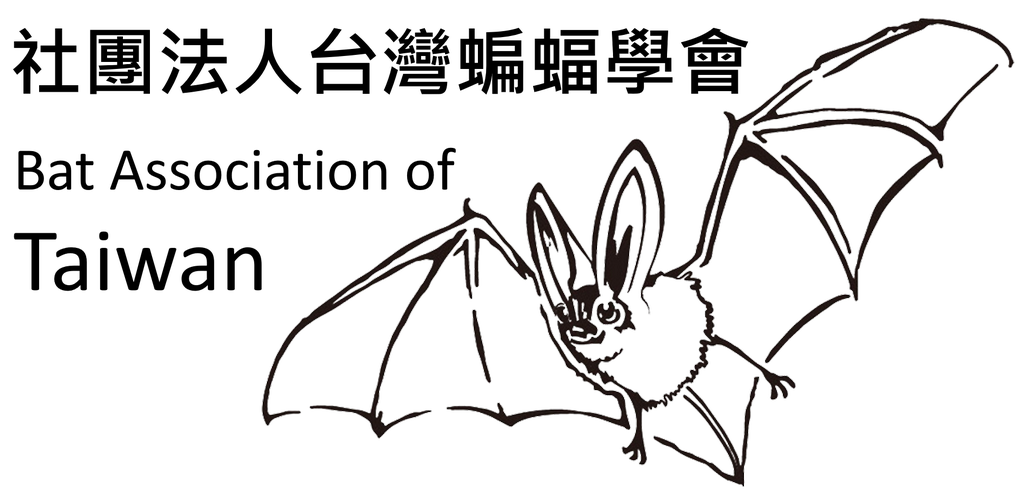蝙蝠研究
2014_兩種近緣食蟲性蝙蝠的食性比較與其生態形值的關聯_陳佳惠
出版年份:2014
研究生:陳佳惠
分類:碩士論文
題目:兩種近緣食蟲性蝙蝠的食性比較與其生態形值的關聯
Title:Comparative food habits of two closely-related insectivorous bats and their eco-morphological correlates
摘要:
動物利用食物資源的機會與限制常受限於自身的生態形值 (eco-morphology) 進而影響資源利用 (resource use),因此瞭解動物的資源利用模式 (pattern),有助於推測物種的生態習性及其與動物形態的關係。 親緣關係相近的物種擁有相似的生態形值,因此為潛在競爭資源的物種。 然而,許多研究顯示近緣物種間存在資源利用差異,因關鍵生態形值上的細微差異會造成近緣物種間探索環境與資源之行為與效率的差異。
對蝙蝠而言,翅膀形值 (wing morphology) 和超音波結構 (echolocation structure) 會影響蝙蝠利用的棲地類型,間接影響蝙蝠覓食遭遇的昆蟲種類。 與體型呈正相關的頭顱骨大小 (skull size) 以及牙齒構造 (tooth structure) 則會影響蝙蝠捕食的獵物大小及硬度。 本研究欲測試假說:在同屬物種裡,關鍵生態形值的細微差異會造成食性 (food habits) 的不同。 本研究在蝙蝠棲息的洞穴中定期收集臺灣葉鼻蝠 (Formosan Leaf-nosed Bat, Hipposideros terasensis Kishida, 1924) 與琉球小葉鼻蝠 (Lesser Leaf-nosed Bat, H. turpis Bangs, 1901) 的排遺,再以顯微鏡辨識排遺內食物碎片,並分析其組成。 這兩種蝙蝠在體型、頭顱骨大小、及超音波頻率上皆有差異。 臺灣葉鼻蝠的超音波頻率範圍在65~75千赫茲 (kHz) 而琉球小葉鼻蝠的超音波頻率範圍為77~84千赫茲。 本研究亦測量琉球小葉鼻蝠的翅膀形值參數 (wing-shape parameters),包括翼承載量 (wing loading)、展弦比 (aspect ratio)、及翼尖形狀指數 (wingtip shape index),並比較其與臺灣葉鼻蝠間的翅膀形值差異。
食性結果顯示,臺灣葉鼻蝠取食至少9個昆蟲目,琉球小葉鼻蝠的食性則包含12目的節肢動物,其中蜘蛛目 (Araneae)、蜻蛉目 (Odonata)、與毛翅目 (Trichoptera) 僅在琉球小葉鼻蝠的排遺中發現。 兩種蝙蝠皆以鞘翅目 (Coleoptera) 為主食,佔了食性中超過20%的相對出現頻度 (relative frequency of occurrence) 以及大約40%的體積百分比 (volume percentage)。 其餘的獵物種類則在兩種蝙蝠的食性間分別佔有不同的比例。 半翅目 (Hemiptera) 和膜翅目 (Hymenoptera) 在臺灣葉鼻蝠的食性中佔有53.8%的相對出現頻度及50.8%的體積百分比。 在琉球小葉鼻蝠的食性中,相對出現頻度較高的類別包含直翅目 (Orthoptera)、半翅目、及蜚蠊目 (Blattodea),但直翅目與鱗翅目 (Lepidoptera) 佔有較高比例的體積百分比。 在臺灣葉鼻蝠的排遺中辨識出21種目以下,大多為科 (family) 的獵物類群 (prey taxon);而琉球小葉鼻蝠的排遺中僅辨別出13種。 在對半翅目的取食中,臺灣葉鼻蝠捕食蟬 (Cicadidae) 的頻度及體積百分比皆顯著高於琉球小葉鼻蝠對蟬的取食。 整體而言,臺灣葉鼻蝠的食性較均勻 (even) 而且異質性 (heterogeneity) 較高,所以臺灣葉鼻蝠的食性寬度 (dietary breadth) (3.21) 較高於琉球小葉鼻蝠的食性寬度 (2.98),而兩者僅有0.67的食性重疊 (dietary overlap)。
除了翼尖形狀指數外,臺灣葉鼻蝠大部分的翅膀形值參數皆大於琉球小葉鼻蝠的翅膀形值參數。 擁有較大翼承載量及較高展弦比的臺灣葉鼻蝠,顯示其有相對較快的飛行速度與相對較差的飛行靈敏度 (maneuverability)。 而琉球小葉鼻蝠的翅膀形值參數顯示其具有相對較佳的飛行靈敏度,加上較高頻率的超音波可以容忍較複雜的環境 (cluttered environment),因此琉球小葉鼻蝠可以在較為複雜的棲地中覓食。 依據蝙蝠的飛行能力與對複雜環境的容忍度,將獵物根據其一般飛行能力分類後分析,擁有較大翼承載量及較高展弦比的臺灣葉鼻蝠取食較高比例飛行速度較快的昆蟲,如膜翅目。 體型較大的臺灣葉鼻蝠擁有較大的頭顱骨及較強的咬合力,其推估之取食昆蟲硬度指數 (3.75) 略高於琉球小葉鼻蝠 (3.67)。
臺灣葉鼻蝠及琉球小葉鼻蝠在食性各方面皆有差異,而食性分析結果符合生態形值,包括翅膀形值參數、體型大小、及超音波結構等因子對蝙蝠食性的預期。 雖然兩種葉鼻蝠的食性多樣性比較並不符合預期,但臺灣葉鼻蝠取食昆蟲目的數量較少,可能其較為均勻的取食各昆蟲目而有較高的異質性。 雖然本研究沒有測量食物量而不能排除兩實驗地區間環境差異對蝙蝠食性的影響,但前人的研究結果顯示:臺灣葉鼻蝠在各地區的食性組成相似,表示地區間食性的差異並不大。 生態形值會限制動物的行為並影響其資源利用,因此生態形值可反映動物的生態需求並作為預測動物資源利用模式的指標。
Abstract:
Ecological morphology presents constraints and opportunities to how animals explore resources by different mechanisms, and in turn may affect the resource use patterns of animals. Closely-related species with similar eco-morphological traits are presumably subjected to similar limitations, and thus are expected to explore similar resources. On the other hand, closely-related species may still display substantially different resource use, because slight differences in key eco-morphological traits may influence their performance and efficiency in exploring environments and resources.
For microchiropterans, wing-shape parameters and echolocation structure often limit the type of habitats they are capable of exploring, which will affect the type of prey encountered. Body size, skull size, and tooth structure may further constrain size or hardness of prey consumed by bats. This study tested the hypothesis that small differences in crucial eco-morphological traits between congeneric species may contribute to different food habits. I conducted dietary analyses on fecal samples of two closely-related insectivorous bats, Hipposideros terasensis Kishida, 1924 and H. turpis Bangs, 1901, which were collected in their summer habitats. These two species differ in body size, skull size, and echolocation call frequency. I also measured related wing parameters, including span, area, and loading of wing, aspect ratio, tip length and area ratios of wing, and wingtip shape index, for these two species to compare their wing morphology.
The diet of H. terasensis comprised of 9 insect orders, and that of H. turpis additionally included Araneae, Odonata, and Trichoptera and contained a total of 12 orders of arthropods. Both species fed primarily on Coleoptera that accounted for more than 20% in frequency of occurrence and about 40% in volume percentage, while the rest prey orders accounted for different proportions in their respective diets. Hemiptera and Hymenoptera accounted for 53.8% of the total frequency of occurrence and contributed to 50.8% of the volume in the diets of H. terasensis. In contrast, Orthoptera, Hemiptera, and Blattodea were more prevalent in the diet of H. turpis, but Orthoptera and Lepidoptera were more abundant in volumes. Below the level of order, I found 21 and 13 prey taxon, mostly families, in the diets of H. terasensis and H. turpis, respectively. Within hemipterans, H. terasensis consumed higher proportions of cicadas than H. turpis. Overall, H. terasensis displayed a more even and thus a more heterogeneous diet than that of H. turpis, with a medium dietary overlap between the two species at 0.67, based on Horn’s index of similarity.
Most wing parameters measured were higher in H. terasensis than those of H. turpis. A higher wing loading and aspect ratio indicate a faster but less maneuverable flight for H. terasensis. In contrast, the flight of H. turpis is expected to be more maneuverable and adapted to near vegetation and the ground. In addition, H. turpis with higher call frequency would be more tolerant to cluttered environments. Incorporating the general flight potentials of insects, dietary results showed that H. terasensis, with higher wing loading and aspect ratio, consumed a higher proportion of faster-flying insects, such as Hymenoptera. The larger body and skull size of H. terasensis suggest a more powerful bite force, and the estimated hardness index of prey eaten by H. terasensis (3.75) was slightly higher than that of H. turpis (3.67).
The food habits differed between H. terasensis and H. turpis in several aspects, and various factors might have contributed to these differences. The dietary results were consistent with the predictions from eco-morphological traits, including body size, wing parameters, and echolocation. Since H. terasensis ate more evenly among each insect order, it ate less number of insect orders but had a more heterogeneity diet. This study did not measure food availability on site, thus can’t rule out the possibility of dietary differences affected by prey availability. The dietary compositions of H. terasensis among sites across Taiwan, however, indicate little dietary variation in space and substantiate our conclusions. Eco-morphological traits constrain animals to explore resources and to a certain extent that have contributed to the different patterns of resource use, thus eco-morphological traits can be a good indicator for resource use patterns of animals with caution.
